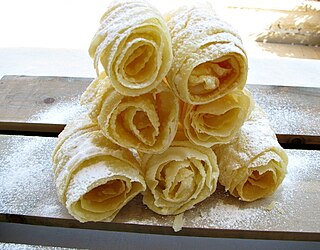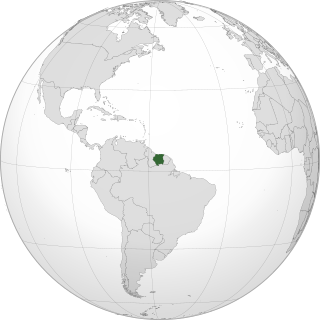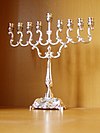Related Research Articles

Challah is a special bread of Ashkenazi Jewish origin, usually braided and typically eaten on ceremonial occasions such as Shabbat and major Jewish holidays. Ritually acceptable challah is made of dough from which a small portion has been set aside as an offering. Challah may also refer to the dough offering. The word is biblical in origin, though originally referred only to the dough offering. Similar braided breads such as kalach and vánočka are found across Central and Eastern Europe.

Jewish cuisine refers to the worldwide cooking traditions of the Jewish people. During its evolution over the course of many centuries, it has been shaped by Jewish dietary laws (kashrut), Jewish festivals and holidays, and traditions centred around Shabbat. Jewish cuisine is influenced by the economics, agriculture, and culinary traditions of the many countries where Jewish communities have settled and varies widely throughout the entire world.

A hamantash is an Ashkenazi Jewish triangular filled-pocket pastry associated with the Jewish holiday of Purim. The name refers to Haman, the villain in the Purim story. In Hebrew, hamantashen are also known as אוזני המן, meaning "Haman's ears". "Haman's ears" also refers to a Sephardic Purim pastry, "Orejas de Haman", thought to originate in Spain and Italy, that is made by frying twisted or rolled strips of dough.

Bevis Marks Synagogue, officially Qahal Kadosh Sha'ar ha-Shamayim, is the oldest synagogue in the United Kingdom in continuous use. It is located off Bevis Marks, Aldgate, in the City of London.

Rugelach is a filled baked confection originating in the Jewish communities of Poland. It is popular in Israel, commonly found in most cafes and bakeries. It is also a popular treat among Jews in the diaspora.

A buñuelo is a fried dough fritter found in Spain, Latin America, and other regions with a historical connection to Spaniards, including Southwest Europe, the Balkans, Anatolia, and other parts of Asia and North Africa. Buñuelos are traditionally prepared at Christmas. It will usually have a filling or a topping. In Mexican cuisine, it is often served with a syrup made with piloncillo.

Syrian Jews are Jews who lived in the region of the modern state of Syria, and their descendants born outside Syria. Syrian Jews derive their origin from two groups: from the Jews who inhabited the region of today's Syria from ancient times ; and from the Sephardi Jews who fled to Syria after the Alhambra Decree forced the expulsion of the Jews from Spain in 1492.

Kichel is a slightly sweet cracker or cookie in Jewish cuisine. Made from eggs, flour, and sugar, the dough is rolled out flat and cut into bow-tie shapes.

Sephardic Jewish cuisine is an assortment of cooking traditions that developed among the Sephardi Jews.

Ahrida (Ohrid) Synagogue is one of the oldest synagogues in Istanbul, Turkey. It is located in Balat, once a thriving Jewish quarter in the city.

Israeli cuisine comprises both local dishes and dishes brought to Israel by Jews from the diaspora. Since before the establishment of the State of Israel in 1948, and particularly since the late 1970s, an Israeli Jewish fusion cuisine has developed.

Fazuelos, fijuelas, hiuelas, deblas, or orecchie di Ammon are Sephardic Jewish pastries of thin fried dough. In Sephardic tradition, they are eaten at Purim; the Italian name recalls the shape of Haman's ears, similarly to the Hebrew name for hamantashen, oznei Haman.
Nusach Ashkenaz is a style of Jewish liturgy conducted by Ashkenazi Jews. It is primarily a way to order and include prayers, and differs from Nusach Sefard and Baladi-rite prayer, and still more from the Sephardic rite proper, in the placement and presence of certain prayers.

Sephardic Bikur Holim Congregation (SBH) is a Sephardic Jewish congregation with a synagogue in the Seward Park neighborhood of Seattle, Washington. The name Bikur Holim means visiting or comforting the sick, an important mitzvah. The first official name of the congregation was Spanish Hebrew Society and Congregation Bikur Holim, shortened to "Sephardic Bikur Holim". For a time in the 1930s, after amalgamation with another congregation, it was known as Bikur Holim Ahavath Ahim Congregation.

The history of the Jews in Suriname starts in 1639, as the English government allowed Spanish and Portuguese Jews from the Netherlands, Portugal and Italy to settle the region, coming to the old capital Torarica.
Noodle latkes, also known as Romanian noodle latkes, pasta latke, or pasta latkes, are a type of latke made with pasta of Romanian Jewish origin, that is traditionally prepared during Hanukkah, although they may be eaten as a side dish during other times of the year.
Pain petri is a braided bread of Moroccan Jewish origin, that is traditionally baked for Shabbat, the Jewish sabbath, as well as Rosh Hashanah and other Holidays, and is popular among the Moroccan Jewish community of Morocco, France, and Israel.
Impade is a cookie of Sephardi Jewish origin that is most commonly found among members of the Venetian Jewish community and their descendants, and is traditionally prepared at Purim, but is also prepared year round.
Marunchinos, also known as Sephardi macaroons, is a popular Israeli cookie of Sephardi Jewish origin made with ground blanched almonds or almond flour, egg whites, sugar or more traditionally honey, spices, and oftentimes dried fruit and orange blossom or rose water, that is traditionally made during Passover (Pesach), as it is one of the few desserts which is unleavened and does not contain chametz.
Hadji bada, also known as Iraqi Jewish almond cookies, is a popular Israeli cookie of Sephardi Jewish origin made with ground blanched almonds or walnuts, egg whites, sugar or more traditionally honey, spices, and oftentimes topped with whole almonds and infused with rose water, that is traditionally made during Passover (Pesach), as it is one of the few desserts which is unleavened and does not contain chametz.
References
- 1 2 3 4 5 "Sephardic Hanukkah Cookies Bring Community Together". My Jewish Learning. 27 November 2017. Retrieved 8 December 2019.
- ↑ "Sephardic Biscochos". Leah Cooks Kosher. Retrieved 8 December 2019.
- ↑ "Biscochos- a Sephardic Tea Biscuit". The Boureka Diary. 25 December 2009. Retrieved 8 December 2019.
- ↑ Marks, Gil. The Encyclopedia of Jewish Food.
- ↑ "Sephardic cookies for Purim". My Jewish Learning. 14 March 2016. Retrieved 8 December 2019.
